

Monster wkp. A monster is any creature, usually found in legends or horror fiction, that is often hideous and may produce fear or physical harm by its appearance and/or its actions.

The word "monster" derives from Latin monstrum, an aberrant occurrence, usually biological, that was taken as a sign that something was wrong within the natural order.[1] The word usually connotes something wrong or evil; a monster is generally morally objectionable, physically or psychologically hideous, and/or a freak of nature. It can also be applied figuratively to a person with similar characteristics like a greedy person or a person who does horrible things.
Mito y leyenda. Susana Guerrero Salazar.
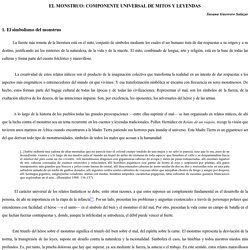
Libro de los monstruos. TERATOLOGÍA RENACENTISTA: La edad de oro de los prodigios Este capítulo es extenso y lo he estructurado en tres partes bien diferenciadas.
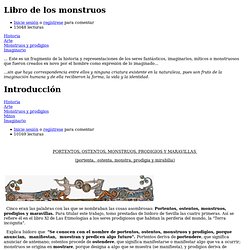
Medieval Imagination. McIlwain-Nashimura, Margot.
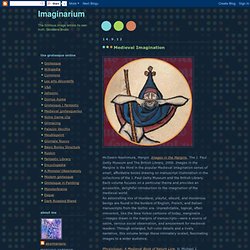
Monstruos clásicos. Monstruosidad en el arte. Macabre & Beautifully Grotesque. Gloomy, Grotesque and Supernatural. ¿Qué es lo siniestro? La cuestión de lo siniestro es una de las grandes cuentas pendientes de la filosofía. Schelling intentó enfrentar el problema de una dilucidación estrictamente filosófica del concepto, pero luego de proponer su famosa definición, desistió y pasó a otro tema.
Dijo Schelling: "Lo siniestro (das Unheimliche) nombra todo aquello que debió haber permanecido en secreto, escondido, y sin embargo ha salido a la luz". Lo siniestro como categoría estética. Elogio de lo siniestro. Vampiros, demonios, brujas, criaturas de la noche, oscuros seres mitológicos.
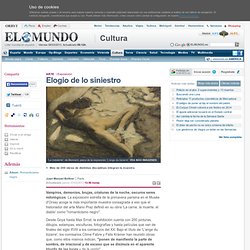
La exposición estrella de la primavera parisina en el Musée d'Orsay acoge la más importante muestra consagrada a eso que el historiador del arte Mario Praz definió en su obra 'La carne, la muerte, el diablo' como "romanticismo negro". Desde Goya hasta Max Ernst, la exhibición cuenta con 200 pinturas, dibujos, estampas, esculturas, fotografías y hasta películas que van de finales del siglo XVIII a los comienzos del XX. Bajo el título de 'L'ange du bizarre', los comisarios Côme Fabre y Felix Krämer han reunido obras que, como ellos mismos indican, "ponen de manifiesto la parte de sombra, de irracional y de exceso que se disimula en el aparente triunfo de las luces y de la razón".
Una de las obras de la exposición. Roberto Ferri - Galleria quadri e dipinti. Characteristics of the Gothic. Gothic Characteristics Bingo. Gothic Elements - Fear and Location. Gothic Elements - Human Limitation and Incarceration. Gothic Elements - History, Class, Gender and Sexuality. Grotesque. Renaissance grotesque motifs in assorted formats.
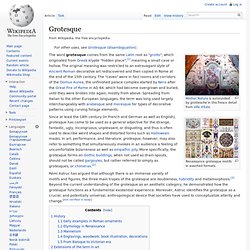
Rémi Astruc has argued that although there is an immense variety of motifs and figures, the three main tropes of the grotesque are doubleness, hybridity and metamorphosis.[3] Beyond the current understanding of the grotesque as an aesthetic category, he demonstrated how the grotesque functions as a fundamental existential experience. Moreover, Astruc identifies the grotesque as a crucial, and potentially universal, anthropological device that societies have used to conceptualize alterity and change. [not verified in body] History[edit] Early examples in Roman ornaments[edit] Arte grotesco: algunos de sus alcances. Grotesco como arte visual.
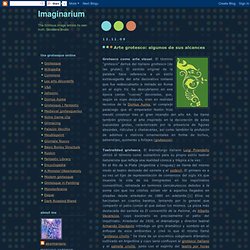
El término "grotesco" deriva del italiano grottesco (de las grutas). El sentido original de la palabra hace referencia a un estilo extravagante del arte decorativo romano que fue redescubierto e imitado en Roma en el siglo XV. Se descubrieron en esa época varias "cuevas" decoradas, que, según se supo después, eran en realidad recintos de la Domus Aurea, el complejo palaciego que el emperador Nerón hizo mandó construir tras el gran incendio del año 64. GROTESQUES selon l'Encyclopédie Larousse. Lorsque, à la fin du XVe s., les Italiens découvrirent à Rome des ruines souterraines, qui leur donnaient l'impression de grottes, ils appelèrent " grotesques " les peintures qui en recouvraient les voûtes et les parois.

Il s'agissait surtout de celles de la maison Dorée de Néron, dont les peintures, rehaussées de stucs très légers, se rattachent au quatrième style pompéien ; celui-ci est caractérisé par des architectures filiformes et végétalisées et par un vocabulaire ornemental composé de plantes et d'animaux, mais aussi de monstres tels que griffons, sphinges et centaures. Pris d'enthousiasme pour cette vision en couleurs de l'Antiquité et pour l'expression de la fantaisie qu'elle leur révélait, les artistes ne tardèrent pas à les imiter et donnèrent également le nom de grotesques aux décorations qu'ils créèrent sous cette influence. El factor grotesco. Exposición.
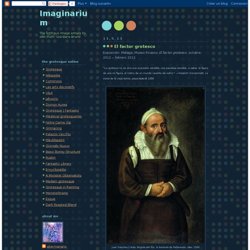
A la búsqueda del factor grotesco. Media and the Grotesque. GROTESQUE.

The chief difficulty encountered in seeking to define the grotesque in its relation to media is—as can be attested to by every theoretician who has sought to do so since the sixteenth century conception of the term in its modern sense—that the grotesque is not an expression of norms, but rather what results from the transgression of them.1 In recognition of the grotesque as “the slipperiest of aesthetic qualities”2 the flurry of nineteenth century writers addressing the grotesque did so by exploring its aesthetic, social and philosophical significance.3 The word itself is rooted in the sixteenth century Italian excavation of ancient palaces, tombs and villas such as Nero’s Domus Aurea in Rome, and the discovery of a fantastical decorative style in the underground chambers called grotte.4 Within the century the term had spread to France and England, where its definitive scope broadened from decorative motifs to encompass literature and even people.
Notes 1. Bibliography Ref. Digital Grotesque - 日本語 (Japanese) Grotesco y fantástico. The Uncanny. Carlos Nine, Colored Relief #2, c. 2009 The uncanny is the weird, the strange, the mysterious, a mingling of the familiar and the unfamiliar. Even Freud, patron of the uncanny, had trouble defining it. Yet the uncanny is everywhere in contemporary culture. Louise Bourgeois, Janus fleuri, 1968. Bronze and golden patina, h: 25.7 x w: 31.8 x d: 21.3 cm. The Uncanny (German, das Unheimliche—literally, "un-home-ly", but ideomatically, "scary", "creepy") is a Freudian concept of an instance where something can be familiar, yet foreign at the same time, resulting in a feeling of it being uncomfortably strange.
Hartmann Schedel, The Monstrous Races: "Blemmyae," from Liber chronicarum (Die Schedelsche Weltchronik, Das Buch der Croniken und Geschichten von Hartmann Schedel), woodcut, 1493. Lo familiar vuelto inquietante. El filósofo decimonónico Friedrich W.J. von Schelling describió lo extraño-inquietante como aquello que debía haber quedado oculto, pero que no obstante se ha manifestado. Resources. Adams, James Luther, and Wilson Yates. Painters and Poets Alike. What if a Painter, in his art to shine, A human head and horse's neck should join; From various creatures put the limbs together, Cover'd with plumes, from ev'ry bird a feather; And in a filthy tail the figure drop, A fish at bottom, a fair maid at top: Viewing a picture of this strange condition, Would you not laugh at such an exhibition? Trust me, my Pisos, wild as this may seem, The volume such, where, like a sick-man's dream, Extravagant conceits throughout prevail, Gross and fantastick, neither head nor tail.
"Poets and Painters ever were allow'd Some daring flight above the vulgar croud. " De monstruos, prodigios y maravillas. John Ruskin advances his theory of the grotesque in Modern Painters and The Stones of Venice, which is an immense three volume work wherein he talks about the history of Venetian art and architecture; sometimes generally, sometimes literally stone by stone. Kayser plus Bakhtin. Books: The Grotesque of Kayser, Bakhtin, and Relatives GROTESQUES. Pictures wherein (as please the Painter) all kinds of odde things are represented whithout anie peculiar sense, or meaning, but only to feed the eye (R. Corgrave, A Dictionnairie of the French and English Tongues, 1611). Factor de desorientación. El terror nos asalta con rigor precisamente porque se trata de nuestro propio mundo, de manera que la confianza que depositábamos en él [el mundo] no resulta ser más que una apariencia. Bakhtin: The Body Grotesque. "Grotesque," Déjà vu, Russia Grotesque (from IT. grottesca, derived from the "Grotto").
Ornaments, which combines a fantastically ornamental and figurative motifs (animals and plants, chimeras, human forms and masks), discovered in the Renaissance during the excavation of underground rooms (caves). Grotesque - the kind of artistic imagery, based on a comic, caricature, burlesque and quirky effect. Grotesque is perceived as a significant distortion of the known or recognized regulatory forms. Grotesque appeared long before it was coined by the term. Eco: Belleza y Fealdad. ¿Lo bello que en lo feo o lo feo que en lo feo? Books: The Grotesque and Its Relatives. Philip Thomson, The Grotesque, 1972 Geoffrey Galt Harpham, On the Grotesque - Strategies of Contradiction in Art and Literature, 1982 Dominique Iehl, Le Grotesque, Presses Universitaires de France, Collection Que sais-je?
, 1997. Pics. The Grotesque. When commonly used in conversation, grotesque means strange, fantastic, ugly or bizarre, and thus is often used to describe weird shapes and distorted forms such as gargoyles on churches or Halloween masks.[1] The term originated in the visual realm as a style of ornamentation characterized by fanciful combinations of intertwined forms. The first to use it in a literary context was Walter Scott in his extended analysis of the work of E.T.A. Hoffmann: On the Supernatural in Fictitious Composition (1827). Polysemy. Because of its inherent characteristics, grotesque may refer to 1. ornamentation, 2. appearance, attitude or behavior, 3. aesthetics. 1. Ornamentation (grottesche). Wikimedia. Language select: From Wikimedia Commons, the free media repository Български: Гротеска Dansk: Det groteske Deutsch: Groteske.
Imaginarium album. Domus Aurea, Rome. La grottesca. La tradition des grotesques. Maniérisme : rébellion mélancolique. L'écriture des grotesques. A Procession of Grotesques. Gloriously Grotesque 19th-Century Pipes. Educar con el ejemplo: la antigua pedagogía teutona y sus efectivas advertencias. Mild grotesques. The Grotesque in Twentieth-Century Art. Francis Bacon. Enthusiastic Despair. The Greatest Painter or a Fascinating Mess? Educathyssen. SER Y NO SER. Francis Bacon y lo Grotesco.
Aspectos grotescos del arte de Bacon. El juego de Bacon. Identity of The Grotesque: Transgression Through Visual Media. Chapman brothers. Long Life to Death. TODO BIEN. The Cute and The Creepy.